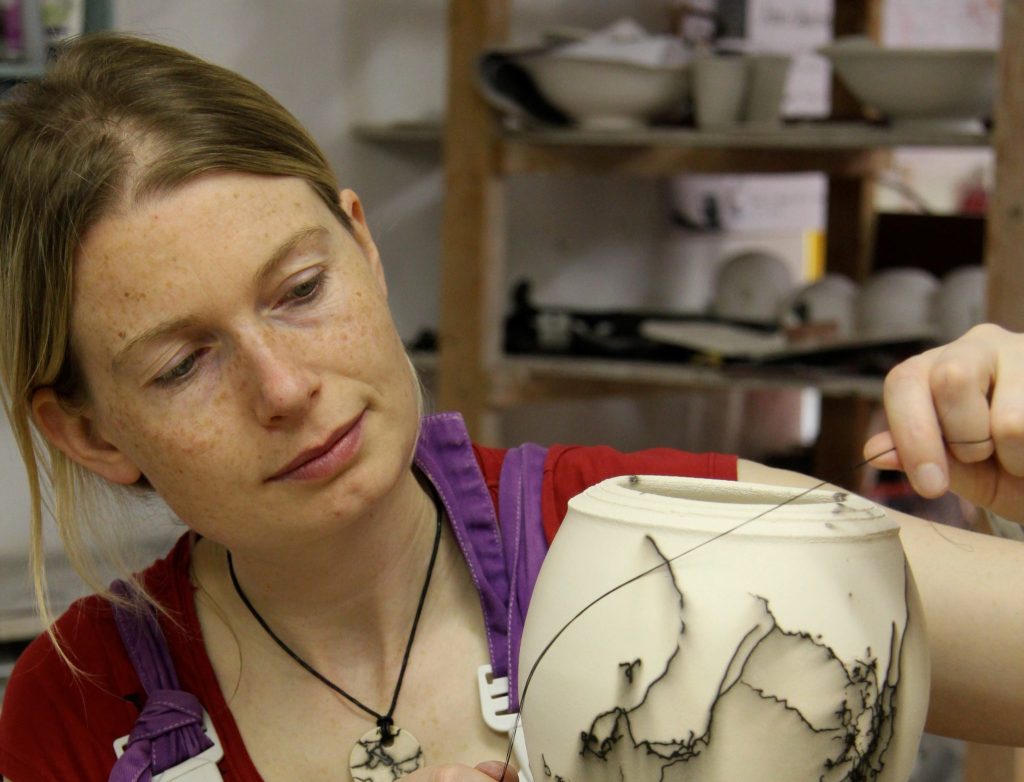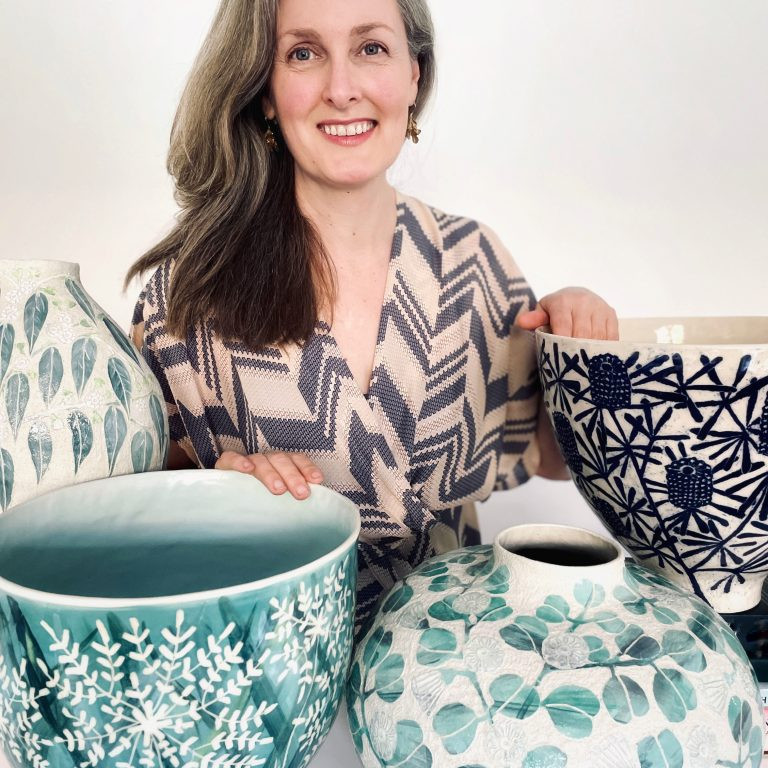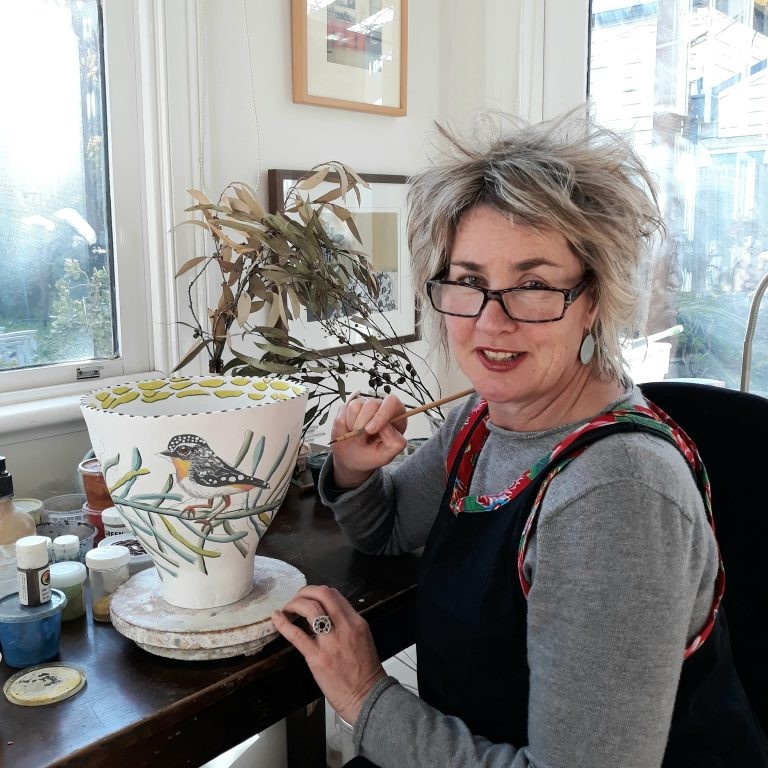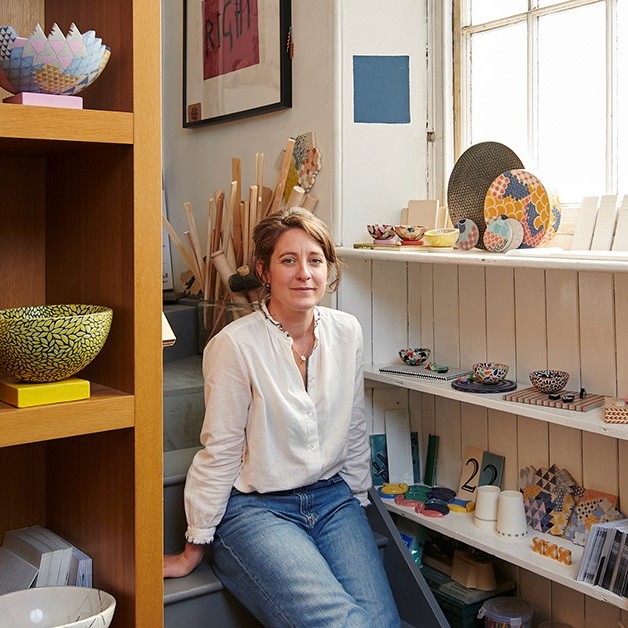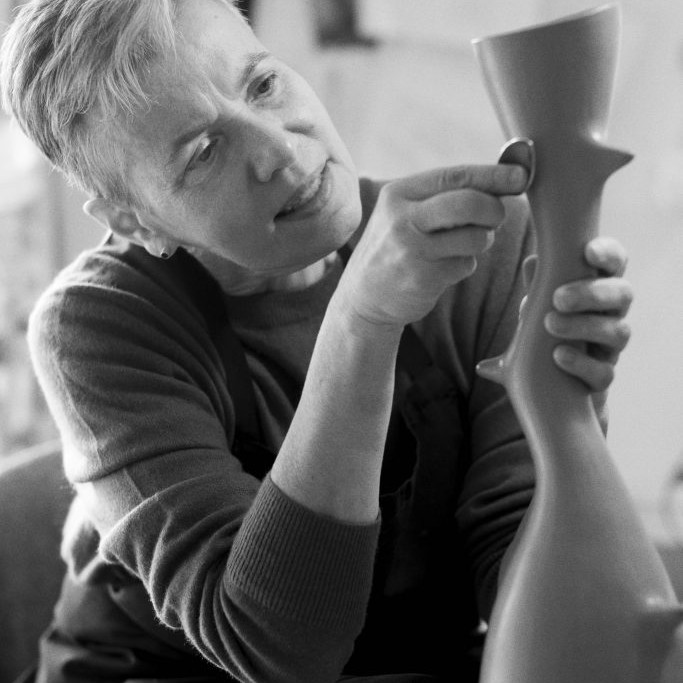Claire Molloy Potter - Rossenarra, Kilmoganny, Ireland
You combine two techniques in your pottery, horsehair and saggar firing. Can you take one piece and explain both the combinations and techniques?
I am mainly known for the horsehair firing technique. This is where a piece is heated up inside a Raku Kiln (a small gas fired Kiln) once the kiln reaches about 800 degrees C the piece is taken out with a pair of tongs. Hair from the mane or tail of a horse is placed on the hot ceramic, the hair twists and turns in the heat and burns onto the surface to form a beautiful black line. As where the hair burns in cannot be fully controlled a unique pattern forms on each piece. It does not matter what colour the hair is it will always turn black as it is the carbon contained within the hair that leaves the mark.
I’ve also recently started to combine saggar firing with the horsehair. For the saggar I use different materials like Epsom salt, seaweed, ferric, sawdust etc on the piece, I then wrap it in tin foil and heat it up in the raku kiln. Again when the kiln is hot enough I take the piece out and add horse hair to the piece.
I really enjoy the unpredictability of this method and I think it complements the horsehair design.
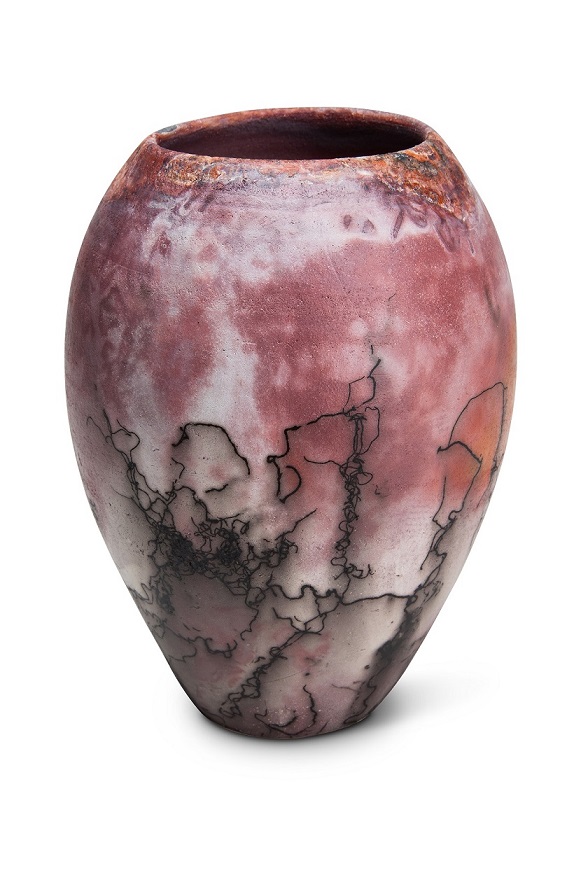
You don’t only use your own horse’s hair but use other horse owner’s horsehair, explain one of these commissions.
Yes I make special pieces for horse owners using hair from their own horses. I get many people contacting me to make pieces with hair from a favourite horse or dog. As a horse owner myself I know how special they can be in our lives. These pieces are a wonderful memento to celebrate this. My pieces can also have the name added to them to make them extra personal. The process is easy, I can be contacted through e-mail where I can send a catalogue of the different pieces I can do. Once a piece is chosen the hair can be posted to me to add to it and once the piece it finished it can be then sent to the customer. I have sent work all over the world form Europe, Canada and U.S to Australia and New Zealand.
I have also created pieces using hair from well-known racehorses and I have made a presentation piece for Paralympic Medallist Dressage rider Helen Kearney using hair from her horse Mr Cool.
Explain your background and current involvement with horses?
I grew up with ponies and horses. When I had ponies I was involved in pony club activities, competing and completing exams. When I grew into horses I took a particular interest in eventing and breaking and training young horses. I trained for a year in college doing horse breeding and training and have also worked excersing race horses and in Coolmore stud breeding race horses. I have also bred my own horses for eventing.
Now since my pottery career has become full time horses are more of a hobby for me. I currently have two mares which I used to breed and a gelding which I ride for leisure.
Can you give us a brief history of Horsehair pottery?
As far as I gather horsehair pottery was started by Native American Navajos. There is a lovely legend/ story that goes as follows:
‘A potter woman discovered this art form when her long hair accidentally blew and made an impression on the hot piece of pottery she was removing from the kiln. She was fascinated by what she saw and decided to try this technique with many other things like straw, pine needles, feathers and finally horse hair.
They found that the thicker and coarser horse hair left striking and clear impressions on the pot as compared to the finer human hair.’
Horses were very important to the Navajo people and they continue to this day to commemorate their horses through horsehair pottery.
When did you first decide to combine both of your loves, pottery and horses?
Horses and working with clay have always been two loves of mine, and I have been torn between the two of them. Growing up as a teenager I was horse mad but also loved art partially working with clay, so when it came to college I choose to do a degree in Fine art ceramics. This meant moving away from home and selling my horse as I didn’t have time to look after him while I was away. After finishing college four years later I really missed horses and took a job riding race horses which led me to do a one year course in horse breeding and training. I was then working with horses for a couple of years when I really missed the creativity of working with clay. I applied and got accepted into the Craft Council of Ireland’s Pottery skills and design course. On this course I really wanted to express my love of horses through clay but didn’t want to make sculptures of horses. I was looking for something more conceptual. For one of our projects I was looking at Native American pottery and I came across the Navajo technique of horsehair pottery. This ticked all the boxes of what I was looking for; I started experimenting with this technique and loved it. And still love it to this day.
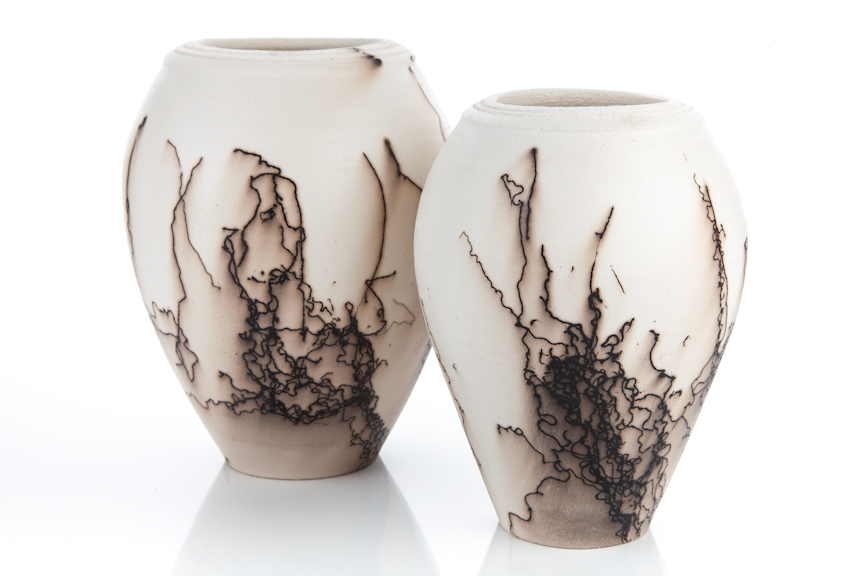
You also do pots with beautiful lids, discuss.
I love the challenge of making beautiful lidded pieces. To me it’s very important to have a well fitted balanced lid. When throwing the jar I have a callipers that I made on the crafts council course to measure the opening for the lid. This makes it easier when making the lid to get the right measurement. All my lids are turned so they are not too heavy. The Knobs or handles are then either thrown directly onto the lid or made by hand and then applied. I always take into consideration the size and shape of the jar when constructing the lid so it works well with the jar, to obtain a nice flow.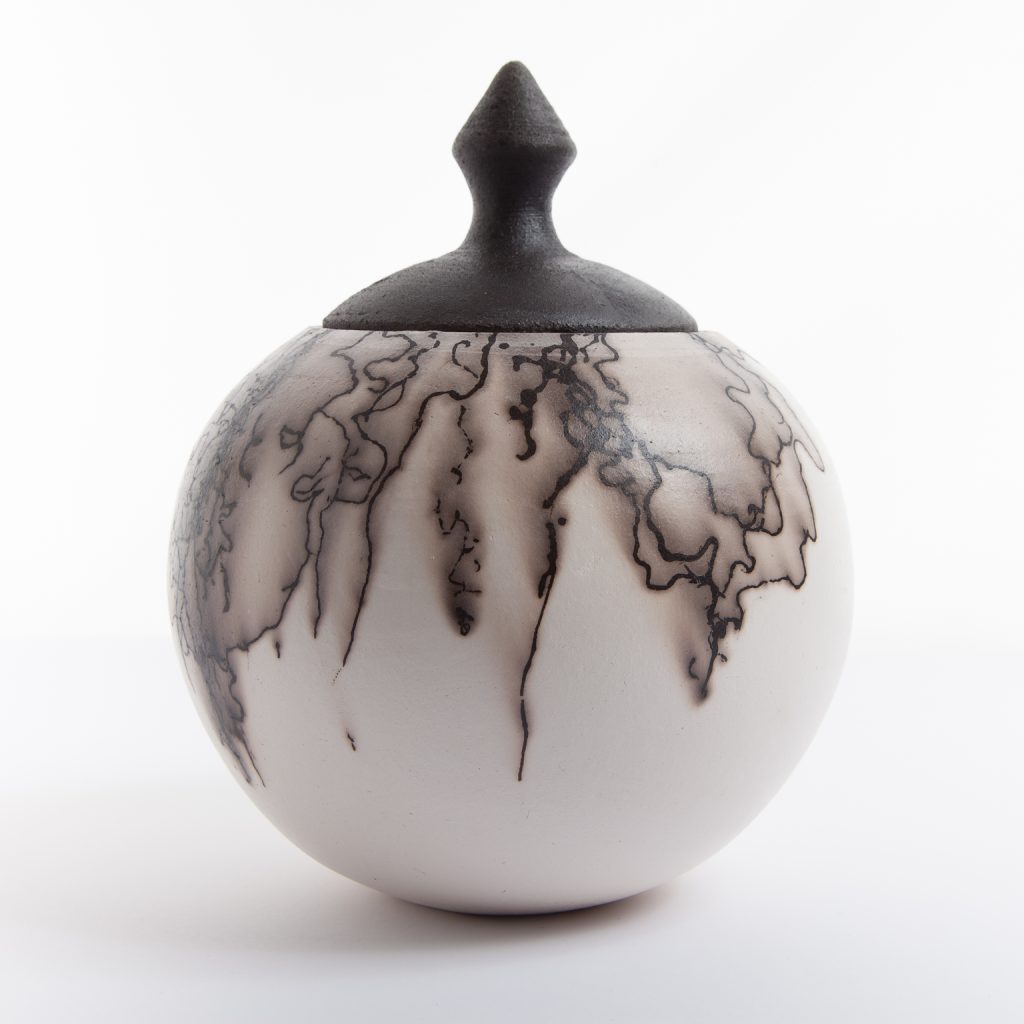
You also make jewellery (pendants) discuss.
I first made a horse hair embellished pendant for myself, purely because when explaining to people what kind of pottery I make using horsehair. Some people never heard of the technique and couldn’t imagine what it looked like, so I made a pendant to wear to show people the effects of the horsehair. People really liked my pendant and asked could I make them one too. So my line of jewellery started and developed into different shapes and then to brooches.
I didn’t know much about making jewellery but learned as I went along getting advice from jeweller friends. I like making simple shapes as the pattern of the horsehair is the main design. I make the brooches as nice and light as possible and with some of the pendants I’m careful not to have them too heavy for around the neck. For my jewellery boxes I chose black to reflect the colour of the horsehair pattern.

As well as jewellery you also make homewares. You have a collection called
‘The Equus Collection’ expand on the collection.
Along with making the horsehair ceramics I really love making functional everyday pieces too. I wanted my functional pieces to have some kind of connection with the horsehair ceramics, so I developed a range called the Equus collection. I commissioned equine artist Michaela Bosnegeanu to sketch some images of horses. The result was two images that I now use and love, The Irish Cob and The Arab. There are plans to develop more images in the future to add to the collection.
I love making large quantities on the wheel; you really get into the swing and rhythm of the process. I again keep the design simple with clean lines and at the moment just use a simple white glaze with a little brown speckling, as I want them to have a contemporary feel and also a focus on the images of the horses.

Discuss the importance of preserving a historical craft in our modern world.
In this age of mass produced ‘throw away’ objects. I think it’s important to appreciate hand crafted items for their quality durability and aesthetics. Historical craft is part of our history and a story of where we came form I think it’s important to keep historical craft methods alive to pass on from generation to generation and keep us in touch with our roots. It also shows what humans could do with very little technology and can give us an appreciation of what we have today.
Contact details
Claire Molloy
www.clairemolloyceramics.com
Claire Molloy, Rossenarra, Kilmoganny, Ireland
Interview by Deborah Blakeley, March, 2017
Think a colleague or friend could benefit from this interview?
Knowledge is one of the biggest assets in any business. So why not forward this on to your friends and colleagues so they too can start taking advantage of the insightful information the artist has given?
Other artists you may be interested in:


